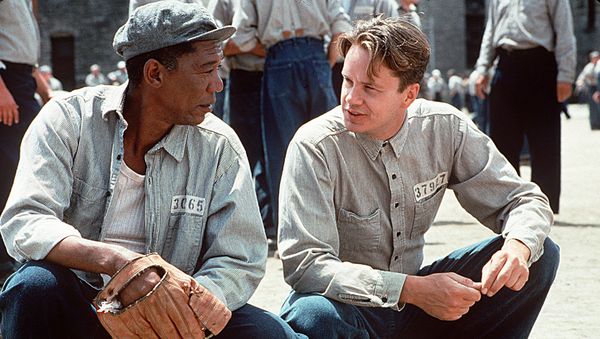Eye For Film >> Movies >> The Shawshank Redemption (1994) Film Review

The story of The Shawshank Redemption is well known. Based on a Stephen King novella, the film was released in 1994 to a warm critical reception, but failed to turn a profit at the box office. Finding an audience through TV and video, it gradually grew to become a phenomenon, a canonised classic, and something close to a religious experience for many. The story may be well known, but the mystery remains: What is it about The Shawshank Redemption that has such a profound effect on people?
The film tells the story of Andy Dufresne (Tim Robbins), an educated banker sentenced to life for the murder of his wife and her lover. In prison, Andy inspires his fellow inmates with his courage and humanity and has a profound effect on Red (Morgan Freeman), an older prisoner, who has given up hope.

Unlike many films of the Nineties, Shawshank has no "high concept" plot premise and is somewhat episodic compared with the tight, linear narratives of closer structured pictures. This sense of freedom in the storytelling allows the film to consistently throw up genuine surprises, as the viewer isn't constantly on guard for clues and plot points. In hindsight, we tend to forget how successfully writer/director Frank Darabont leads us to expect a very different resolution.
Now it is regarded as a feelgood classic, which only achieves such popularity by first visiting the darkest places imaginable. It's easy to forget how violent and depressing the story is and it's only by evoking a powerful sense of horror that Darabont's masterful screenplay earns its climactic feeling of release.
The film's inspirational power is heightened by the use of religious references and symbolism throughout. Some argue, compellingly, that it can be read as a religious parable, with Andy as a Christ figure, who sacrifices himself in order to inspire those around him, and is figuratively killed and reborn.
Part of the film's popularity is the way it warrants rewatching, as the quality of the writing means each new viewing throws up fresh details and delights. The tension, when the warden checks Andy's cell, for example, is only fully appreciated second time round. Similarly, the wonderful dialogue is best enjoyed with the leisure of already knowing the story; Andy's reply in court, for example, to the accusation that the disappearance of his gun is convenient: "Since I am innocent of this crime, sir, I find it decidedly inconvenient that the gun was never found."
The story obviously inspired the makers as much as it does the audience, as it marks a career high for most of the considerable talents involved. The cinematography by long-time Coen Brothers collaborator Roger Deakins is awe-inspiring. Freeman and Robbins were never more touching and restrained and Darabont's direction displays the mastery of a man making his twentieth film, rather than, as this was, his debut.
The Shawshank Redemption is perhaps the only undisputed classic of the Nineties, although it's more popular with the public than with critics, who tend to be slightly sniffy about it's feelgood magic. In this respect, it has much in common with the other classics, with which it is often compared, such as Casablanca and It's A Wonderful Life, which suggests that it will remain a favourite of the people for decades to come.
Reviewed on: 30 Sep 2004


















